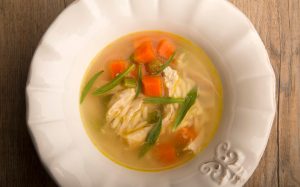
Summer is here, and while this is a great time of year to enjoy outdoor activities, such as barbecues and picnics, rising temperatures create an ideal environment for bacteria to rapidly multiply and increase the risk for foodborne illness.
Food safety during the summer is especially important for those of us going through cancer therapy. Cancer treatments can decrease your white blood cell count, making you more susceptible to infections. People with cancer are also more likely to have a longer and more serious infection if they develop foodborne illness.
The leading cause of foodborne illness is eating perishable food that has been in the temperature range between 40°F and 140°F for more than two hours. This range is called the “danger zone” because bacteria can grow very quickly.
Here are some food safety tips to help keep you safe during the summer.
Clean
As harmful bacteria can quickly spread throughout the kitchen, washing hands and surfaces often is important in lowering the risk of foodborne illness.
- Wash hands and food surfaces often.
- Wash hands with warm, soapy water for 20 seconds after touching raw meats, using the restroom, changing diapers, blowing your nose, coughing, or sneezing, handling garbage bags, or touching pets.
- If there is not a safe water source when you are away from home, bring soap, water, paper towels, disposable moist towelettes, and hand sanitizer for cleaning hands and food surfaces.
- Keep all utensils and platters clean when preparing food.
Separate
Avoiding cross-contamination, the method by which bacteria spread from one food item to another, is vital. Keeping raw meats away from fresh products will help to decrease the risk of cross-contamination.
- Separate raw meat from ready-to-eat foods.
- Raw meat: beef, lamb, pork, wild game, poultry, seafood, and eggs
- Ready to eat foods: fruits, vegetables, bread products, and nuts
- Place raw meats in separate plastic bags and keep away from produce or other ready-to-eat foods.
- Consider having two cutting boards available – one for raw meat (disinfect after each use), and one for ready to eat foods (disinfect weekly).
- When barbecuing or grilling, always use a clean plate and utensils for the cooked meat.
- Do not reuse marinades used on raw foods unless you bring them to a boil first.
Cook
Foods are safer to eat when they are cooked to recommended temperatures.
- Keep a food thermometer with you and cook foods to proper temperatures when barbecuing or grilling.
- Recommended safe minimum internal temperature:
- 165°F: Turkey/chicken/duck, whole or ground
- Sauces, soups, gravies
- Hotdogs, luncheon meats, bologna, and other deli meats
- 160°F: Ground beef, pork or lamb, egg dishes
- 145°F: Beef/pork/lamb steaks, roasts, chops, fish, and seafood
- 165°F: Turkey/chicken/duck, whole or ground
- Keep cooked food hot. Grilled food can be kept hot until served by placing to the side of the grill away from the coals. Cooked food can also be wrapped with foil and placed in an insulated container until ready to serve for up to 2 hours.
Chill
Keeping perishable foods at cold temperatures will help to slow the growth of harmful bacteria.
- Keep your refrigerator at a constant temperature of 40°F or below.
- Use coolers when away from home to keep perishable foods and beverages at safe temperatures:
- Keep cooler packed with ice, gel packs, or frozen water bottles and fill contents to full capacity.
- Stock cooler before traveling to keep foods and beverages at safe temperatures all day long.
- Always keep coolers closed. Place a thermometer inside the cooler to be sure it’s keeping foods and beverages at 40°F or below.
- Place cooler out of the sun and in a shady area.
- Wash fresh fruits and vegetables under clean running water before packing and store in the cooler.
- Raw meats, poultry, fish, and seafood should be securely wrapped and stored away from other perishable foods.
- Refrigerate food to 40°F or below within two hours. When the outdoor temperature is above 90°F, food should not be left out for more than one hour.
By following safe food practices this summer, you can reduce your risk for foodborne illness.
Paula Charuhas Macris, MS, RD, CSO, FAND, CD is a registered dietitian with more than 30 years of experience in cancer care. Paula works primarily with hematopoietic cell transplant patients at Fred Hutch South Lake Union and at the Fred Hutch Survivorship Clinic. She has a special interest in working with children and families. Paula is a fellow of the Academy of Nutrition and Dietetics and is a board-certified specialist in oncology nutrition.












Reviews & Comments
No reviews yet.
Leave a Review or Comment